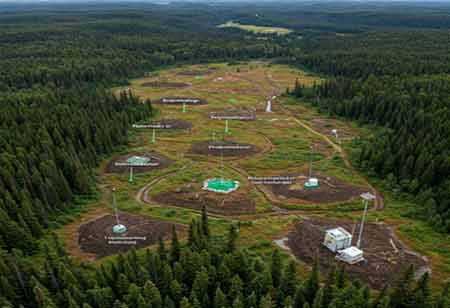Thank you for Subscribing to Environmental Business Review Weekly Brief
Green Technologies for a Cleaner Canada and the Soil Remediation Movement
Canada’s soil remediation sector is advancing through green technologies, addressing contamination challenges with sustainable, innovative, and data-driven solutions across diverse and remote environments.

By
Environmental Business Review | Monday, August 25, 2025
Stay ahead of the industry with exclusive feature stories on the top companies, expert insights and the latest news delivered straight to your inbox. Subscribe today.
As Canada’s environmental priorities continue to evolve, the soil remediation sector has become increasingly vital for safeguarding the ecosystem. The nation's expansive and varied terrain, spanning urban centers to remote industrial zones, brings both challenges and opportunities for effective soil restoration. Addressing diverse forms of contamination, from industrial chemicals to oil spills, demands innovative and adaptable solutions. Amid rising environmental awareness and regulatory frameworks, Canada’s top environmental remediation companies are leveraging innovation to address the dual challenges of contamination and sustainability.
A Leap Forward in Soil Restoration
The need for advanced remediation technologies has never been more urgent in Canada. Soil contamination from past industrial activities, mining, and agricultural practices continues to be a significant issue, especially in areas that were once heavily reliant on resource extraction. However, a shift has been made toward cleaner, greener, and more efficient technologies, prioritizing sustainability.
Phytoremediation is one area of innovation in which plants absorb or break down pollutants in the soil. This sustainable technique is gaining popularity, especially in urban areas and former mining sites. Certain plants can absorb metals like lead and mercury, effectively extracting harmful contaminants from the environment. This green technology helps restore the ecosystem in an eco-friendly and cost-effectively manner, providing a viable long-term solution for some of Canada’s most polluted sites.
Meanwhile, electrokinetic remediation has emerged as an exciting technology for addressing heavy metal contamination. An electric field can more effectively mobilize and remove Metals and organic chemicals from polluted soil. This technology benefits difficult-to-reach places, such as isolated northern regions, where conventional soil extraction techniques are impractical. As these technologies become more widely used, they demonstrate a dedication to lessening the negative environmental effects of remediation operations, consistent with Canada’s sustainability objective.
Challenges in the Soil Remediation Sector
While Canada’s soil remediation industry is advancing, it faces considerable challenges that must be navigated. The sheer scale of contamination across the country is one such hurdle. Sites once hubs of industrial activity, such as abandoned mines, oil sands sites, and agricultural lands, remain burdened with pollutants that continue to leach into the environment. These legacy pollutants pose long-term environmental risks and complicate remediation efforts.
One of the most pressing issues is the contamination caused by oil sand extraction. The oil sands industry has left behind large quantities of contaminated soil, particularly hydrocarbons and heavy metals. The region’s scale and the pollution’s complexity have made remediation efforts slow and expensive. Despite this, companies increasingly turn to new remediation technologies and seek collaborative efforts with academic institutions to find cost-effective ways to restore these sites.
A growing problem is the presence of pollutants such as per- and polyfluoroalkyl substances (PFAS), which are frequently found in consumer goods, industrial processes, firefighting foam, and hydrocarbons. Because they are difficult to break down, these substances are often called “forever chemicals” due to their extreme environmental persistence. With increasing concerns over their toxicity, especially around drinking water sources and agricultural land, soil remediation companies in Canada are under pressure to find solutions for PFAS contamination. This is no easy task, as most conventional treatment methods do not efficiently remove these substances from the soil.
The geography of Canada also complicates remediation efforts. Its vast size and often remote, rugged terrain can make it challenging to access contaminated sites, particularly in the northern regions. In some areas, the absence of infrastructure and harsh environmental conditions further hinder the deployment of traditional soil remediation technologies. This has led to a need for innovations that can be deployed effectively, even in the most isolated locations.
The Path Toward Sustainable Remediation
The growing need for ecologically friendly and sustainable solutions is fueling the explosive growth of the soil remediation sector in Canada. Green remediation technologies, especially bioremediation, are at the forefront of this shift. These methods offer a less invasive, cost-effective alternative to traditional soil cleanup techniques. As concerns over global climate change rise, the need for sustainable, eco-friendly practices becomes more urgent, positioning biotechnology as a crucial tool in restoring contaminated lands across Canada.
Another significant trend in the industry is the move towards integrated remediation solutions. Companies are combining multiple technologies to address complex contamination issues effectively. For example, integrating bioremediation with electrokinetic processes offers a powerful method for treating various pollutants, such as hydrocarbons and heavy metals. This combined approach enhances the efficiency and adaptability of remediation efforts, especially in diverse environments like Canada’s vast industrial and remote regions.
The rise of data-driven remediation offers new growth opportunities. Real-time monitoring, GIS mapping, and advanced data analytics help remediation teams assess contamination levels and track cleanup progress. In remote areas, these technologies improve decision-making and resource allocation. Collaboration among government agencies, environmental NGOs, and private companies fosters innovation and accelerates new remediation techniques, ensuring Canadian firms lead in effective and economically viable soil remediation solutions.





